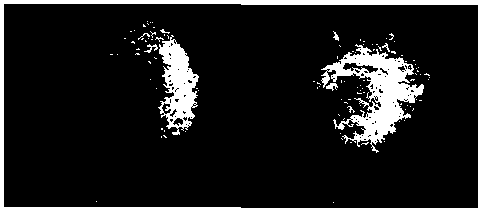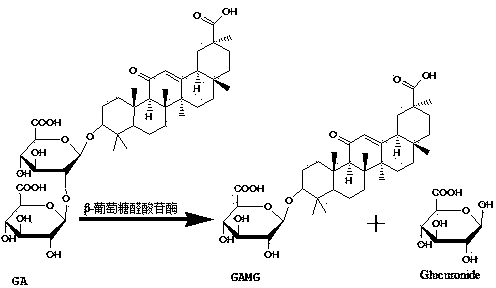Dongxiang wild rice endophytic fungus strain capable of transforming glycyrrhizic acid to produce glycyrrhetinic acid monoglucuronide
A technology of glycyrrhizin and endophytic fungi, which is applied in the field of biotransformation, can solve the problems of poor catalytic orientation, pollute the environment, low conversion rate and the like, and achieve the effects of less by-products, high reaction efficiency and simple steps.
- Summary
- Abstract
- Description
- Claims
- Application Information
AI Technical Summary
Problems solved by technology
Method used
Image
Examples
Embodiment 1
[0027] Embodiment 1: Dongxiang wild rice endophytic fungus of the present invention Aspergillus flavus Isolation of DX-SEL2
[0028] (1) Collect complete Dongxiang wild rice and process it immediately after returning to the laboratory.
[0029] (2) Roots, stems and leaves are preliminarily sterilized by soaking in 75% ethanol for 5 minutes, then soaking in 0.1% mercuric acid for 8 minutes, and rinsing with sterile water to sterilize the surface of the tissues.
[0030] (3) Cut off the two ends of the above-mentioned treated stem with sterilized scissors, then cut the stem with two ends longitudinally, divide it into two, and cut it into small pieces of 0.1×0.5 cm. The edge of the leaf is cut off with sterilized scissors, and the edge-cut blade is also cut into small pieces of about 0.2×0.5 cm. They were respectively placed on PDA medium supplemented with 60 μg / L streptomycin and 0.5 g / L potassium dichromate, and cultured in an incubator at 28°C. In order to check the surf...
Embodiment 2
[0033] Example 2: The present invention screens out the Dongxiang wild rice endophytic fungus that directional transforms glycyrrhizic acid into glycyrrhetin Aspergillus flavus DX-SEL2.
[0034] (1) Plate primary screening: the isolated endophytic fungi of O. sativa Dongxiang were activated and inoculated in a solid screening medium with glycyrrhizic acid as the sole carbon source. In the control group, glucose was used instead of glycyrrhizic acid as the sole carbon source. At 28°C, cultivate for 7 days, and screen out the strains that can grow well.
[0035] The screening medium is; every liter of medium contains 3.0 g of glycyrrhizic acid, KH 2 PO 4 2.2 g, NH 4 NO 3 3.0 g, NaCl 0.5 g, yeast powder 0.05 g, MgSO 4 0.12g, CaCl 2 0.014g, FeSO 4 0.014g, ZnSO 4 ·7H 2 O 2.9 mg, MnCl 2 4H 2 O 2.0mg, CuSO 4 ·5H 2 O 0.25mg, CoCl 2 ·6H 2 O 0.24 mg, Na 2 MoO 4 2H 2 O 0.24mg, H 3 BO 3 0.03mg, 20g agar powder (not added to liquid medium), the rest is pure wate...
Embodiment 3
[0038] Example 3: Endophytic fungi Aspergillus flavus Conversion of Glycyrrhizic Acid to Glycyrrhetin by DX-SEL2
[0039] Dongxiang wild rice endophytic fungus Aspergillus flavus DX-SEL2 was inserted into the seed medium for 3 days at 28°C and 250 rpm, and then transferred to the transformation medium at 30% inoculum size, and cultured on a shaker at 35°C and 250 rpm for 7 days. The bacteria were removed by centrifugation, the fermentation broth was collected, and the transformation product was detected by HPLC.
[0040] The composition of the seed medium is as follows: every liter of medium contains 25g of glucose, 0.2g of glycyrrhizic acid (or ammonium glycyrrhizinate), KH 2 PO 4 2.0g, NH 4 NO 3 3g, NaCl 0.5g, yeast powder 0.1g, MgSO 4 0.12g, CaCl 2 0.2g, FeSO 4 0.014g, ZnSO 4 ·7H 2 O 2.9 mg, MnCl 2 4H 2 O2.0mg, CuSO 4 ·5H 2 O 0.25mg, CoCl 2 ·6H 2 O 0.24mg, Na 2 MoO 4 2H 2 O 0.24mg, H 3 BO 3 0.03mg, the rest is pure water, adjust the pH to 6.0....
PUM
 Login to View More
Login to View More Abstract
Description
Claims
Application Information
 Login to View More
Login to View More - R&D
- Intellectual Property
- Life Sciences
- Materials
- Tech Scout
- Unparalleled Data Quality
- Higher Quality Content
- 60% Fewer Hallucinations
Browse by: Latest US Patents, China's latest patents, Technical Efficacy Thesaurus, Application Domain, Technology Topic, Popular Technical Reports.
© 2025 PatSnap. All rights reserved.Legal|Privacy policy|Modern Slavery Act Transparency Statement|Sitemap|About US| Contact US: help@patsnap.com



